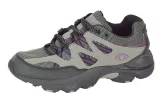I met a pilgrim who used sandals with socks on a rainy day. The whole bottom, the WHOLE bottom of one of his feet turned into one big blister. He had to stop his camino. Could not walk on that foot anymore.
@
William Donovan, i know you get all this great advise here and it is al meant very well, but when it comes to shoes, all you can do is listen to the stories but dont use them as advice.
Nobody had the same feet as you do. Picking the right shoe or boot is something only you can do. Please dont buy something because you hear lots of people here say they enjoyed it or "these are the best" or "you dont need .....". Dont even buy a shoe because the guy in the store says "whatever he he says".
Buy the shoes that are "you", be it heavy boots or lightweigt running shoes. Then, and only then have you made the right choice. You have to feel comfortable in them.
About the support. Do you mean ankle support? Do you twist your ankle alot? I dont see why you would need the extra support, but again, your condition is not mine, is not somebody elses.
The
camino Frances can easily be walked on normal running shoes. If you want some more grip here and their, flexible trailrunners. If hou feel these shoes are to soft, then you can move onto stiffer trailrunners or the lightest category walking/hiking boots. After that comes the category of medium weight hiking boots. Looking at other categories would be a waist of time. Your not climbing Mt. Everest

Whatever you decide, please make sure you feel extremely comfortable with the shoe you pick.
For sandals, i dont know. I dont have any. I use flipflops to shower and to stoll around at night. I cant see myself walking 800km in a sandal. I am amazed other people can. So there you go again....i could not do that, i think the majority would not do it, but maybe you can and feel great with them. If so, go for it.
I would recommended to carry and extra pair of shoes then, some parts might indeed be somewhat rocky and open shoes on rocky terrain? I dont know :-$




















